
Ultrasonic Aspirator Tip Variations: Instrumentation Assessment
Jeffrey D. Klopfenstein, MD
Robert F. Spetzler, MD
Division of Neurological Surgery, Barrow Neurological Institute, St. Joseph’s Hospital and Medical Center, Phoenix, Arizona
Abstract
This article introduces a new set of tips for the ultrasonic aspirator. Presented are the Claw(TM) and Pineapple(TM) tips for intracranial bone removal and the Barracuda(TM) tip for resection of tenacious, fibrous intracranial tumors. These tips were used in more than 40 patients and significantly enhanced the surgeon’s ability to resect intracranial tumors and bony structures safely and efficiently.
Key Words: surgical instrumentation, tips, ultrasonic aspirator
The ultrasonic aspirator was introduced to neurosurgery in 1978 after first being applied in dental and ophthalmological procedures.[1] Since its introduction to neurosurgery, the ultrasonic aspirator has become an invaluable tool for the resection of all types of brain tumors. Recent modifications, including handpiece and tip alterations, have provided significant improvements by expanding the application of this incredibly useful instrument.[2,4]
This article introduces five new tip variations for the ultrasonic aspirator. Each variation has a unique tip morphology with a specific function. The tips and their roles in surgery are described.
Device Description
Each head was designed for use with the Sonopet UST-2001 (Miwatec Co., Ltd., Kawasaki, Kanagawa, Japan). The tips were developed in cooperation with and manufactured by Synergetics, Incorporated (St. Charles, Missouri)
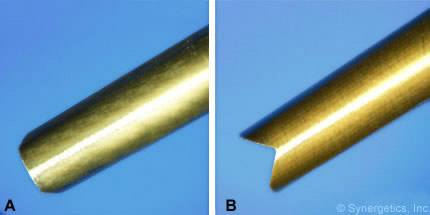
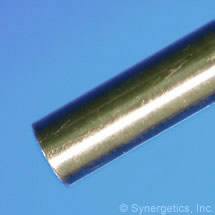
The Barracuda Tip
The key feature of the Barracuda tip (Fig. 1) is its sharpened beveled edge at the distal shaft orifice. Unlike the standard tip (Fig. 2), which has a circular orifice, the Barracuda tip contains two V-shaped notches opposite one another creating the appearance of a fishmouth. While the portion of the instrument tip in direct contact with the tissue remains blunted, the sharpened edges and fishmouth morphology create a cutting instrument at the head of the ultrasonic aspirator. In combination with the suction intrinsic to the ultrasonic aspirator, these features enable fine, sharp dissection of the target tissue. Thus, the Barracuda is particularly useful for tenacious, fibrotic tumors.
The Claw Tip
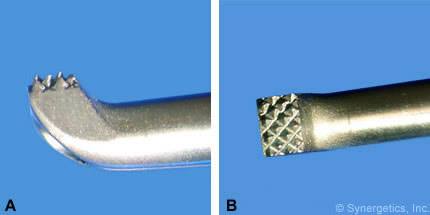
from Synergetics, Inc.
The Claw tip contains an expanded head with numerous pyramidal projections on its flattened contact surface (Fig. 3). These projections create an abrasive interface between the ultrasonic aspirator and target tissue. Additionally, helical reliefs machined into the shaft of the tip redirect the ultrasonic pulse from a purely longitudinal excursion to one that is primarily torsional. As such, tissue distal to the tip of the instrument is unaffected by the cavitational action. The main role of the Claw tip is the microsurgical removal of calcified material, including bone in and around vital neural structures. This tip is available in multiple angulations from the plane of the ultrasonic aspirator shaft. The numerous interface sizes permit its use in relatively tight anatomic quarters. Due to the primarily torsional motion, adjacent soft tissue structures are largely ignored.
The Pineapple Tip
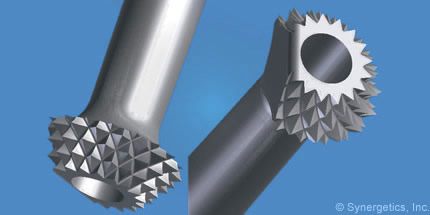
The Pineapple tip consists of an expanded head with pyramidal projections located circumferentially around the distal shaft orifice (Fig. 4). Again, the projections serve as an abrasive surface for bone removal, while the helical reliefs within the shaft transition the ultrasonic pulse from longitudinal to torsional. The primary use of the Pineapple tip is for the dissection of bone, similar to the Claw tip. The key functional difference between the tips involves the surgeon’s hand motion. The Pineapple tip requires a rotatory motion with 360-degree abrasion whereas the Claw tip involves a linear, scraping motion. The Pineapple tip is thus best suited for inside-out bone dissection once the superficial cortex has been removed.
Other Tips
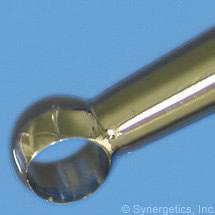
Also available are a straight knifelike tip and a ring curette tip (Fig. 5). As suggested by their names, the former contains a cutting blade whereas the latter contains ring curettes of various sizes. In our experience thus far, these two tips have provided insufficient advantage over either the conventional straight ultrasonic aspirator tip or the Barracuda tip to be useful.
Discussion
To date we have applied the Barracuda tip, the Claw tip, or the Pineapple tip in more than 40 patients who underwent craniotomies for a variety of pathologies. Our experience has demonstrated significant utility for each of these three tip variations. Thus far their use has been associated with no problems.
The Barracuda tip significantly reduces the difficulty and time needed to resect tenacious fibrotic tumors. Even at the highest ultrasonic aspirator power settings, some tumors are very resistant to resection with the conventional straight ultrasonic aspirator tip. In the past, this situation required the surgeon to resect the tumor using means other than ultrasonic aspiration, including manual curettage, electrocautery loop dissection, or simple bipolar electrocauterization and sharp dissection. These methods are time consuming, and manual curettage and loop electrocautery arguably pose an elevated risk to surrounding normal structures.
When the straight ultrasonic aspirator tip is insufficient, we have found the Barracuda tip to be an excellent alternative. Its sharpened beveled edges and fishmouth orifice create a sharp dissecting instrument intrinsic to the ultrasonic aspirator. Its use permits the sharp release and simultaneous aspiration of tenacious tumor tissues. Our experience suggests that tenacious, fibrotic tumors can be resected efficiently, safely, and effectively using the Barracuda tip. Because of its increased cutting capability, however, the Barracuda tip should not be used near critical structures.
The Claw and Pineapple tips provide an excellent alternative to the high-speed drill for removing intracranial bone. The risks of drilling include potential thermal and mechanical injury to surrounding neural structures.[3,5] These risks suggest the need for an alternative method for removing intracranial bone in selected situations. We have found that these two tips as well as the ultrasonic bone curette introduced by Hadeishi and coworkers[2] enable bone to be removed while essentially eliminating the risks associated with drilling.
Our experience with the Claw and Pineapple tips has primarily involved removal of the anterior clinoid process, posterior clinoid process, and superior aspect of the clivus. Conceivably, these tips also could be used to remove other intracranial bony structures such as the jugular tubercle and posterior wall of the internal auditory meatus. Bone is first removed with the Claw tip by the surgeon using a linear scraping motion to remove the exposed cortex and underlying cancellous bone. If the targeted bony structure requires significant debulking, the Claw tip is used to penetrate the exposed cortex. The Pineapple tip is then used to debulk the structure internally using a rotating wrist motion. Using these techniques, we have experienced no complications associated with bone removal and no loss of efficiency when compared with drilling.
The Barracuda Claw and Pineapple tips are simple variations of the ultrasonic aspirator that allow safe and efficient resection of tumors and intracranial bony structures. These tips enhance the neurosurgical armamentarium for tackling difficult intracranial pathologies.
Disclosure
The senior author is a stockholder in and has a royalty agreement with the company that manufactures the presented instruments (Synergetics, St. Charles, Missouri).
References
- Flamm ES, Ransohoff J, Wuchinich D, et al: Preliminary experience with ultrasonic aspiration in neurosurgery. Neurosurgery 2:240-245, 1978
- Hadeishi H, Suzuki A, Yasui N, et al: Anterior clinoidectomy and opening of the internal auditory canal using an ultrasonic bone curette. Neurosurgery 52:867-870, 2003
- Matthews LS, Hirsch C: Temperatures measured in human cortical bone when drilling. J Bone Joint Surg Am 54:297-308, 1972
- Sawamura Y, Fukushima T, Terasaka S, et al: Development of a handpiece and probes for a microsurgical ultrasonic aspirator: instrumentation and application. Neurosurgery 45:1192-1196, 1999
- Toews AR, Bailey JV, Townsend HG, et al: Effect of feed rate and drill speed on temperatures in equine cortical bone. Am J Vet Res 60:942-944, 1999
